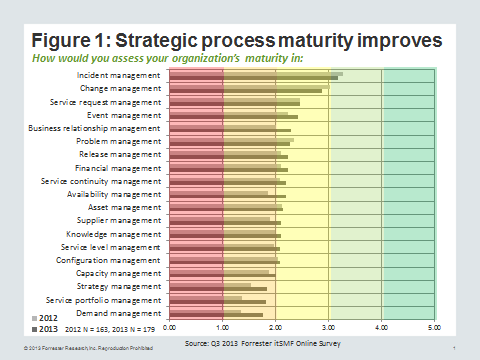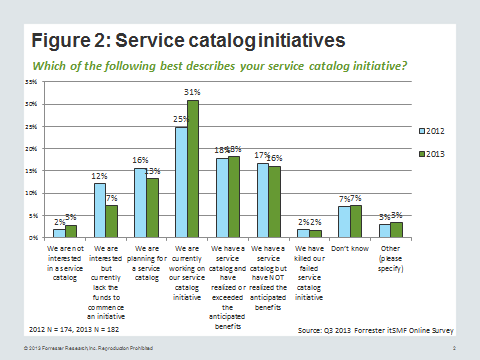itSMF FUSION 13 – GRADUATION AND REVOLUTION
Last week, Forrester’s Service Management and Automation team attended FUSION 13, an annual conference jointly hosted by itSMF USA and HDI, in Nashville, Tennessee. FUSION is a key conference for IT Service Management professionals – for three days ITSM pros are immersed in a content rich environment where they're encouraged to share knowledge and learn from one another, as well as from a plethora of industry experts, practitioners, vendors, and thought leaders alike. It's impossible to leave without having made new friends and new discoveries in the realm of IT Service Management. Approximately 2000 ITSM professionals attended the 2013 conference, with the theme "graduate to better service management."
The buzz of this year's event can be easily put into two terms: revolution and status quo. Yes, you read that correctly. And while these two terms are quite contradictory, when put into context they actually are somewhat related – don't worry, we'll explain. First, the status quo:
At FUSION 13, we presented the results from our third annual ITSM survey Forrester does in conjunction with itSMF USA, and not much changed year-over-year. Aside from a few minor rumblings, ITSM maintained the status quo, and in this case, no news… is news:
· Strategic process maturity improves slightly. Notably, Service Portfolio Management and Demand Management took a leap. Though these processes are ranked lowest in maturity, this jump is encouraging – it shows a refocus of attention away from reactive, firefighting processes (i.e. incident and change) in favor of more proactive, strategic processes (see Figure 1). And while incident and change management dipped slightly in the self-assessments, in reality they improved with MTTR decreasing slightly and slightly fewer incidents related to changes (though, change management is still quite dismal).

· Less are planning, and more are doing, a service catalog. There were some changes on the left side of this chart, while the right side remained nearly identical year-over-year (see Figure 2). Lack of funding is less of an issue for service catalog initiatives, and the number of ITSM professionals currently working on a service catalog grew. A service catalog is not a diet, it's a lifestyle change – proper implementation takes time. Forrester predicts that in time, those who have realized the anticipated benefits of their service catalog will rise; it is an essential part of the service-centric organization.

Other areas devoid of much surprise:
· ITIL continues to have a positive impact on operational productivity, operational costs, and service quality, while IT's reputation with the business continues to struggle
· CMDB development is rudimentary, but market maturity is optimistic
· DevOps trends, as the relationship between application development & delivery and infrastructure & operations is characterized as slightly more seamless and collaborative than isolated
· Service desk loyalty is still very high – 57% of ITSM professionals don't plan to switch vendors in the next 2 years, though 2% more do, and the number of those who were undecided dropped slightly.
The most significant change was:
· 2013 is the breakout year for SaaS. When asked how they plan to purchase management and automation software over the next two years, for the first time "Delivered via SaaS" rather than "Classic perpetual license" was the most popular choice. As most of you know, SaaS has been on a tear for a couple of years now – it's neat to finally see that reflected in the data.
Want more data? You're in luck. This quarter we will be publishing a report, riddled with survey findings, focusing on the state and direction of IT Service Management in 2013 to 2014. I will also be hosting a webinar on this same topic in December (exact date TBD).
Now, put down your pencils, and get ready to storm the barricades — it's a revolution!! This is the exciting part, because we mean it when we say "revolution."
Here's what happened: A variety of Service Management minds (practitioners, consultants, vendors, leaders, executives, and educators), including our very own Glenn O'Donnell, got together and decided enough was enough. They have declared that "our industry has become stagnated by a systemic and fundamentally broken set of attitudes and behaviors" and "the Service Management community MUST change!" And this stagnation is evident in the survey results. Not much happened. ITSM professionals continue to struggle, with slight slivers of hope here and there. We cannot expect different results if we do not alter our approach – and at this point we need more than just to alter… we need to transform… to revolt.
Behold: The Service Management Inaugural Congress This is a call to action, folks. Be brave. Be bold. Join the revolution. Sign here.
At the same conference AXELOS, a new joint venture for the Best Management Practiceportfolio, was answering some questions on the future of ITIL. Much of this is still a work in progress, AXELOS is still very much in transition mode, but be on the lookout for further updates; we are meeting with AXELOS to see what's developing, and will share our thoughts with you.
All-in-all, FUSION 13 was a fantastic conference. Not only was it interesting and informative, but there were cowboy hats, line-dancing galore, a mechanical bull… itSMF USA, HDI, and ITSM professionals sure know how to have a fun 😉
As always, we welcome your input, comments, thoughts, and ideas.
CHEERS!
Your Forrester Service Management & Automation team!